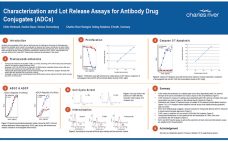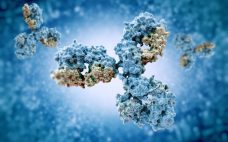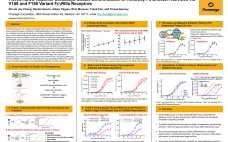Using the label-free optical technique of Bio-Layer Interferometry (BLI), the Octet platform provides real-time analysis of molecular interactions. It relies on the robust and easy-to-use Dip and Read™ format, which provides faster time to results relative to technologies like ELISA and SPR. It also operates in a fluidics-free format, thereby minimizing the complexity in analyte detection by fluidics-based technologies like SPR. It provides high-throughput analysis, with the option of analyzing to 96 samples simultaneously, thereby increasing analytical productivity. It has…
Analytical
Characterization Platform for Structural and Functional Feature Investigation of Bispecific Molecules
Bispecific antibodies (BsAbs ) bind to two or more targets which could be different antigens or different epitopes. Structurally, one type of bispecific antibody is similar to an IgG which contains an Fc region, and other bispecifics do not have an Fc region and typically have a relatively small molecular weight. Therefore, the characterization for a bispecific is more challenging than for a typical monoclonal antibody because of this variation in structure. The poster here discusses a set of platform…
Step-wise strategy to address process characterization and late phase development – toward the definition of a standardized approach
Drivers for process characterization and late phase development include improving process understanding, enhancing process robustness, and assurance that the process delivers consistent product quality within all Proven Acceptable Ranges (PARs). Regulator’s expectations for biologic submissions include the application of statistical methods to improve the confidence of the PARs and knowledge of the design space for a process. Different approaches have been reported for process characterization but contain common elements including risk assessment, scale-down model qualification, and statistical design of experiments.…
Characterization and Lot Release Assays for Antibody Drug Conjugates
Antibody-drug conjugates (ADCs) add an additional level of challenge to testing of biotherapeutics. Besides the antibody, which needs to be evaluated for potential and known mechanisms of action (MoA), there is a cytostatic compound conjugated that alters the behavior of the antibody-vehicle within the typical assays. Therefore, characterization of new innovators as well as biosimilarity assessment is even more challenging than it is for antibody therapeutics. Using the example of Trastuzumab emtansine, Charles River has set up a panel of…
Keeping Host Cell Protein ELISAs Covered
Biological drugs (or biologics) are manufactured by living systems such as microorganisms, and plant and animal cells. Cell lines, like Chinese hamster ovary (CHO), can be engineered to work as cellular factories to produce biologics in addition to their own biological molecules. Host cell proteins (HCPs) are biological by-products of these cellular factories. They are one of the main impurities in harvested cell culture fluid (HCCF), and tend to be released when the cells die or are damaged. These HCPs…
Rapid High Performance Quantification of Human IgG Using an Automated Gyrolab System
The development and manufacture of biotherapeutics requires efficient and timely analytical support to monitor both quantity and quality in products and processes. Productivity is important already during early development. Further downstream, selected cell lines must be optimized for productivity, followed by bioprocess development to yield g/L concentrations of IgG product. The immunoassays that are often used to determine IgG titer must have the flexibility to measure the broad range of concentrations encountered during cell-line and process development, and Gyrolab huIgG…
Evaluation of Rapid Quantitation Methods for Titer, HCP and ProA By Gyrolab Platform During In-Process Development
Getting biopharmaceuticals through development and into clinical proof-of-concept fast and efficiently is critical for success in our industry. Therefore, high-throughput upstream and downstream process development approaches are increasingly being implemented. Hence, innovative and high-throughput analytical technologies are needed to support rapid process development. A novel automated analytical platform-Gyrolab xP workstation was investigated for the analysis of IgG titer, Host Cell Protein (HCP) and leached ProA during in-process development. The assays are automated within a Gyrolab compact disc (CD) containing affinity-capture…
Paired ADCC Reporter Bioassays Enable Differentiation of Antibody Fc Effector Activities via V158 and F158 Variant FcyRIIIa Receptors
Antibody-dependent cell-mediated cytotoxicity (ADCC) contributes to clinical efficacy of a broad range of therapeutic antibodies. FcγRIIIa polymorphism of individual cancer patients are correlated with clinical efficacy of some of these antibody drugs. Classic ADCC cytotoxicity assays rely on primary effector cells, which are highly heterogeneous and variable. To quantitatively measure antibody activity and evaluate the impact of FcγRIIIa polymorphism, we developed a pair of reporter-based ADCC assays using two engineered effector cell lines in Jurkat that stably express an NFAT-RE driven…
Enhancing Efficiency and Economics in Process Development and Quality Control of Biotherapeutics
Analytical techniques that measure protein quantity and quality are used in nearly all stages of research, process development, quality control and manufacturing of biotherapeutics. UV spectroscopy, ELISA and HPLC have been in use for decades for protein quantitation in physiological and process samples, and continue to be the workhorses despite their many limitations. Biopharmaceutical companies have enthusiastically adopted Pall ForteBio’s Octet® systems due to their high throughput capabilities, decreased sample preparation requirements, and low cost of operations. The Octet systems…
The Importance of Thresholding in Imaging Analysis of Protein Aggregates
Dynamic imaging particle analysis (DIPA) shows much greater sensitivity to transparent particles, such as protein aggregates, than light obscuration can. While not yet fully accepted in industry compendia, DIPA is being used increasingly in the formulation process for characterization of sub-visible particulates in biologics. DIPA measures particle size and shape by first creating a binary image based upon a defined threshold from the background value for each pixel in the image. The resulting binary image is used for all particle…










